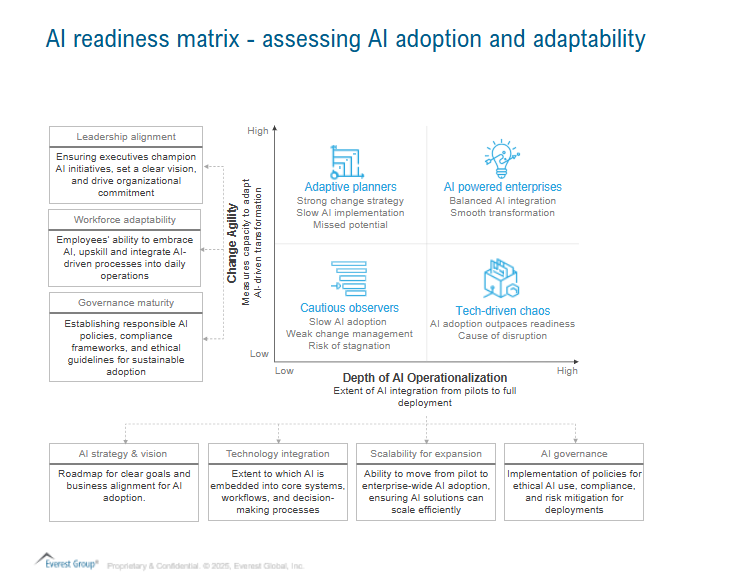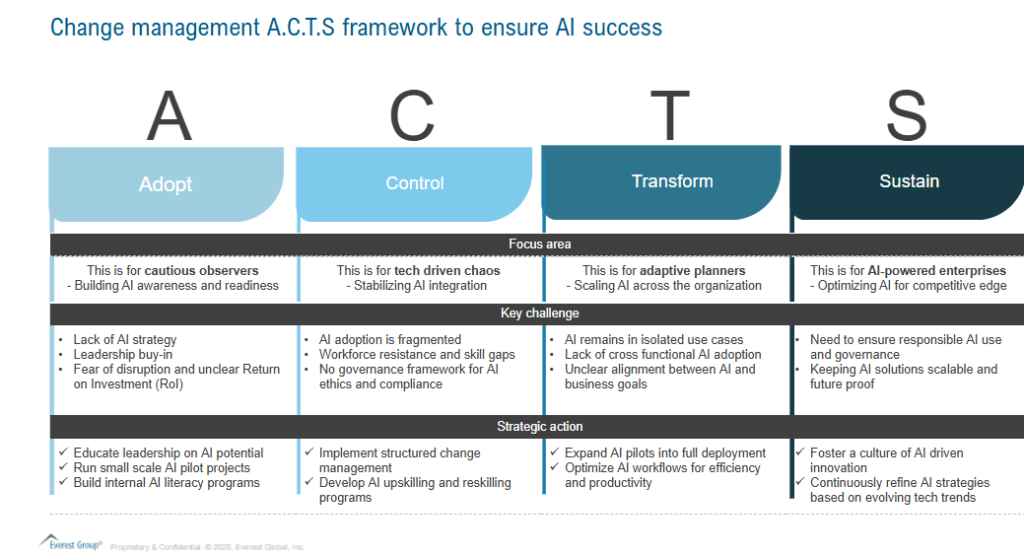
Artificial intelligence (AI) is rewriting the rules of business, transforming workflows, redefining job roles, and reshaping entire industries. But here’s the catch: without the right change management strategy, AI adoption can create chaos instead of competitive advantage.
So, how can enterprises turn disruption into opportunity? Read on to explore the key strategies for navigating AI-driven change with confidence and clarity.
Reach out to discuss this topic in depth.
AI disruption: a transformation like no other
The AI revolution isn’t coming, it’s already here. Across industries, AI has evolved from being just another tool to becoming a powerful force reshaping business models, decision-making, and operations. Enterprises that effectively harness AI now gain a significant edge, while those that lag behind face inefficiencies, workforce resistance, and competitive disadvantages.
Take financial giants like Goldman Sachs and JP Morgan, which leverage AI to refine financial analysis and streamline operations. In the education sector, Pearson has integrated AI into its products, influencing both business strategy and learning experiences. Telstra, led by Chief Executive Officer (CEO) Vicki Brady, has committed $700 million in a joint venture with Accenture to fast-track AI integration across its operations. These examples underscore the scale of AI-driven change and the urgent need for enterprises to manage this transformation effectively.
Why is AI change management a business imperative?
The rush to adopt AI is real. Enterprises see it as a pathway to efficiency, smarter decision-making, and innovation. But here’s the challenge – AI adoption without structured change management can lead to disaster.
Even industry leaders have stumbled. McDonald’s attempted to streamline its drive-thru operations by implementing AI-powered ordering systems across 100 locations. However, the technology frequently misinterpreted customer orders, leading to widespread frustration and negative publicity. The initiative’s shortcomings were widely shared on social media, with instances of customers receiving incorrect or excessive orders.
This isn’t an isolated case either. Across industries, failed AI rollouts have resulted in operational disruptions, employee resistance, and reputational damage.
The biggest obstacles? Workforce anxiety over job displacement, leadership struggles with AI ethics and compliance, and a lack of clear communication and training. Organizations that fail to guide their workforce through AI adoption risk more than inefficiencies, they risk losing trust, credibility, and a competitive edge. The winners in this AI era won’t be the fastest adopters, but the ones who ensure AI empowers their teams rather than disrupts them.
AI success begins with a strategic foundation
AI adoption isn’t just about implementing technology, it’s about reshaping how businesses operate. Enterprises that don’t manage this change risk workforce resistance, governance failures, and AI misalignment with business goals.
Striking the right balance between AI-driven automation and change readiness is critical. Some enterprises rush into AI-driven transformation but face internal pushback, while others focus on cultural adaptation but struggle with execution. The key question organizations must ask now is: are we adopting AI in a controlled, strategic manner, or is the pace of change outstripping our teams’ ability to adapt?
A structured approach is essential. Exhibit 1 provides a strategic lens for assessing AI maturity and determining the right actions for a smooth, disruption-free transition.

Exhibit 1: This matrix can be used to identify the current AI maturity level of enterprises
Bridging the AI readiness gap
Organizations embarking on AI transformation face a clear fork in the road: will AI be a driver of innovation or a source of disruption? The difference often lies in having a clear strategy.
Darren Hardman, Microsoft UK’s head, highlights that many British firms are “stuck in neutral” when it comes to AI adoption, due to the absence of formal AI strategies. This has resulted in a growing productivity gap between AI adopters and laggards. Similarly, Olaf Groth, a global strategist, emphasizes the need for adaptive leadership that blends foresight with empathy to navigate the complexities of AI-driven structural shifts.
AI success isn’t about blindly diving into adoption, it’s about executing change intelligently. Enterprises exist at different stages of AI maturity: some cautiously exploring AI’s possibilities, others rapidly deploying AI without structure, and a few optimizing AI at scale. Without a clear change management strategy, businesses risk fragmented AI implementation and governance failures.
To bridge this gap, organizations need a phased approach that aligns AI adoption with organizational readiness. Exhibit 2 presents a progressive framework to help enterprises manage AI-driven change while mitigating risks and maximizing value.

Exhibit 2: A.C.T.S. is a progressive approach which can be used by enterprises to navigate AI-driven change effectively while mitigating risks and maximizing value
AI leadership is change leadership
The success of AI implementation isn’t just about technology either, it’s about leadership too. Enterprises that have mastered AI transformation demonstrate that structured change management is the key to unlocking AI’s full potential.
Microsoft embedded responsible AI principles early into its adoption strategy, ensuring governance and workforce upskilling. J&J has mandated Generative AI (gen AI) training for over 56,000 employees and offered immersive AI programs. UK-based law firm VWV has involved their trainee solicitors in developing and executing its AI strategy, fostering a culture of engagement and innovation. These initiatives prove that AI isn’t just about technological innovation, it’s about leading structured change.
Enterprises that embrace structured change management, such as the A.C.T.S. framework, can mitigate risks, ensure workforce alignment, and create long-term value from AI adoption. The question is no longer whether AI will disrupt industries, but which organizations will harness it effectively and lead the transformation.
If you found this blog interesting, check out our Navigating The Agentic AI Tech Landscape: Discovering The Ideal Strategic Partner | Blog – Everest Group, which delves deeper into another topic regarding AI.
To explore how structured change management can help your organization successfully navigate AI transformation, contact Abhishek Sengupta ([email protected]) and Oishi Mazumder ([email protected]).










